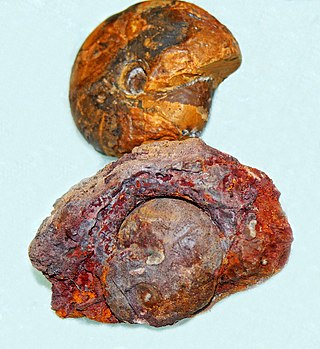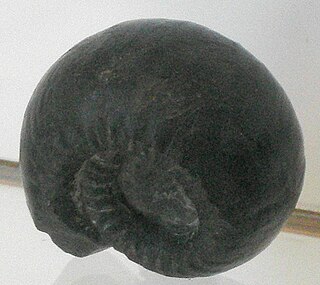
Ammonoids are extinct spiral shelled cephalopods comprising the subclass Ammonoidea. They are more closely related to living coleoids than they are to shelled nautiloids. The earliest ammonoids appeared during the Devonian, with the last species vanishing during or soon after the Cretaceous–Paleogene extinction event. They are often called ammonites, which is most frequently used for members of the order Ammonitida, the only remaining group of ammonoids from the Jurassic up until their extinction.
Alaoceras is an ammonoid cephalopod from the upper Paleozoic included in the goniatitid family Cravenoceratidae, named by Ruzhentsev & Bogoslovskaya in 1971.
Arkanites is a goniatitid ammonite that lived during the Early Pennsylvanian that has been found in Arkansas and Oklahoma in the U.S.
Baschkirites is an extinct cephalopod genus belonging to the ammonoid order Goniatitida that lived during the Early Carboniferous (Bashkirian).
Beyrichoceras is a genus belonging to the goniatitid family Muensteroceratidae, a group of ammonoids, extinct shelled cephalopods related to belemnites and recent coleoids and more distantly to the nautiloids

Beyrichoceras is a genus belonging to the goniatitid family Maxigoniatitidae that lived during the Mississippian Period

Gastrioceratoidea is one of 17 superfamilies in the suborder Goniatitina, ammonoid cephalopods from the Late Paleozoic.

Goniatitidae is one of three families included in the ammonoid cephalopod superfamily Goniatitoidea, known from the Lower Mississippian to the Upper Permian. They have sutures that form 8 lobes and characteristically lack sculpture. The ventral lobe, as for the superfamily, is bifurcated.
Thalassoceratidae a family of late Paleozoic ammonites included in the goniatitid superfamily Thalassoceratoidea along with the Bisatoceratidae. Some eight genera are included, although the specific number and exactly which depends on the particular classification.
The Ammonellipsitinae is a subfamily within the Pericyclidae, a family within the goniatitid superfamily Pericycloidea from the Lower Carboniferous (Mississippian) characterized by having a suture in which the sides of the ventral lobe diverge and the first lateral saddle is acute or subacute, and in which the immature and juvenile shell has a wide umbilicus.

Prolecanitida is an order of extinct ammonoid cephalopods, the major Late Paleozoic group of ammonoids alongside the order Goniatitida. Prolecanitids had narrow shells, discoidal (disc-shaped) to thinly lenticular (lens-shaped). They retained a retrochoanitic siphuncle, a simple form with septal necks extending backwards. As is typical for ammonoids, the siphuncle sits along the ventral margin of the shell.

Prolecanitoidea is a taxonomic superfamily of ammonoids in the order Prolecanitida. Prolecanitoidea is one of two superfamilies in the order, along with the younger and more complex Medlicottioidea. The Prolecanitoidea were a low-diversity and morphologically conservative group. They lived from the Lower Carboniferous up to the Middle Permian. Their shells are generally smooth and discoidal, with a rounded lower edge, a moderate to large umbilicus, and goniatitic to ceratitic sutures. Suture complexity varies from 10 up to 22 total lobes ; new lobes are added from subdivision of saddles adjacent to the original main umbilical lobe.
The Trigonoceratidae is a family of coiled nautiloid cephalopods that lived during the period from the Early Carboniferous (Mississippian) to the Early Permian.
The Centroceratidae is the ancestral family of the Trigonoceratoidea and of the equivalent Centroceratina; extinct shelled cephalopods belonging to the order Nautilida
Karagandoceratoidea is an Early Carboniferous (Mississippian) superfamily within the ammonoid order, Goniatitida, said to contain the Karagandoceratidae and Prodromitidae.
The Karagondoceratidae is a small family of tornoceratin Goniatitida from the Lower Carboniferous which typifies the Karagandoceratoidea, in which it is included.
Pachylyroceras is a large, generally subglobular, Upper Mississippian gonitite and included in the cephalopod subclass Ammonoidea.
The Uddenitinae a subfamily of the Medlicottiidae, a family of ammonoid cephalopods included in the Prolecanitida. The Uddenitinae, proposed by Miller and Furnish, and known from the Pennsylvanian and Lower Permian, are transitional between the ancestral Pronoritidae and the more traditional medlicottiids.
Masonoceras is a genus of Karagondoceratids from Lower Mississippian strata, the shell of which is thinly subdiscoidal to discoidal with an acute ventral margin in late ontogeny. Whorls are strongly embracing, the umbilicus narrow to occlude. The mature external suture contains a wide trifid ventral lobe, the flanking prongs longer than the medial, an asymmetrically rounded lateral saddle and a deeper asymmetric pointed lateral lobe. Internal molds of the type, Mesoceras Kentuckiense show the presence of a broad hyponomic sinus flanked by high rounded vantrolateral salients.
Branneroceras is a goniatitid genus from the Late Carboniferous. Their fossils have been found in Nunavut, Canada, and in Arkansas and Texas, USA.




